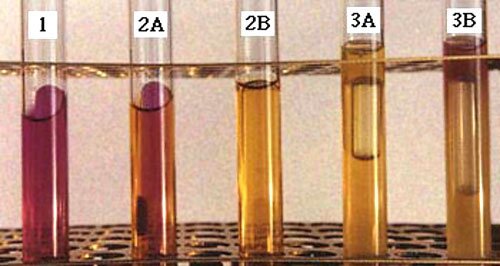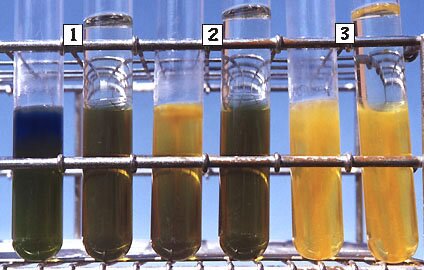Differential Media:
|
|
Introduction & ReviewFirst, a quick review of respiration vs. fermentation (from the Bacteriology 102 lab manual): In our introductory laboratory courses, we deal mostly with chemotrophic bacteria – primarily the chemoheterotrophs. Depending on the abilities of any specific chemotrophic organism and the environment in which it is found, the catabolic pathway is involved with either oxidative or substrate-level phosphorylation. If the former, the organism is obtaining energy by respiration; if the latter, the process is fermentation. Relative comparisons are made between respiration and fermentation in the following outline. (The three kinds of "phosphorylation" are diagrammed under respiration, fermentation and phototrophy on the catabolism page.)
Both Glucose Fermentation Broth (as used in our lab courses) and Glucose O/F Medium include the following major ingredients:
Glucose Fermentation BrothTesting whether an organism can ferment glucose is one of the basic, primary tests in the identification of chemoheterotrophic bacteria. For this test we routinely use a "Glucose Fermentation Broth."
Note the examples shown below.
Furthermore, with any of the reactions shown here, amino acids and/or glucose can be used as sources of carbon, but determination of what is or is not used as a carbon source cannot be made with this medium. Glucose O/F MediumOriginal Paper: Rudolph Hugh and Einar Leifson. 1953. "The Taxonomic Significance of Fermentative versus Oxidative Metabolism of Carbohydrates by Various Gram Negative Bacteria." J. Bacteriol. 66 (1): 24-26. You can download this paper as a .pdf file from the link provided here. The original intention of this medium was to be able to differentiate between gram-negative bacteria (1) that can ferment, (2) that only catabolize glucose by respiration and (3) that do not catabolize glucose at all. This differentiation is not as important in the identification of gram-positive bacteria, and it so happens that gram-positive bacteria do not grow in Glucose O/F Medium well (if at all) anyway – probably because of some sensitivity to the pH indicator. It is a waste of time and money to use this medium to characterize gram-positive cultures. Whether an organism can respire or ferment glucose can be tested with Glucose O/F Medium. A small amount of acid production can be associated with glucose respiration. The original paper which describes the medium gives the example of the Entner-Douderoff pathway that is utilized by a variety of generally gram-negative bacteria (including Pseudomonas) to convert glucose to pyruvate – an alternative method of pyruvate formation to that of the Embden-Meyeroff pathway. (Pyruvate is further oxidized to CO2 in the aerobic respiration process.) Among the intermediates in the Entner-Douderoff pathway are forms of gluconic acid. So, where a strictly aerobic organism producing this acid is growing – i.e., at the top of the medium where O2 is available – a net acidic reaction will be seen. However, this acidic reaction would be rendered indistinguishable if the organism were a facultative anaerobe – in which case the large amount of acid (produced by fermentation in the anaerobic environment of the tube) would be diffusing throughout the entire medium. Duplicate tubes are inoculated for each organism, and the medium in one of the tubes is overlayed with mineral oil. Mineral oil does not in itself cause anaerobic conditions but rather prevents oxygen from continuing to diffuse into the medium. After incubation, one looks for the presence and location of growth and acid. It is important to emphasize that this medium contains relatively less peptone and more glucose than Glucose Fermentation Broth, so the acid associated with respiration can be detected in the aerobic part of the non-overlayed tube – if it is not made indistinguishable by acid production from fermentation which turns both tubes yellow throughout. Note the examples shown below. For each pair of tubes, the tube on the right was overlayed with mineral oil after inoculation.
Additional comparisons between these two media are illustrated and discussed on "Page 2." A discussion of these media with regard to their formulation is given here. For certain groups of bacteria, different formulations of Glucose Fermentation Broth are employed which satisfy special growth requirements. For example, clinical streptococci and dairy lactobacilli require a much richer basal medium than that provided by peptone. Likewise, a variation of Glucose O/F Medium is used for the characterization of Staphylococcus and Micrococcus. Bergey's Manual and other reference books give more specific information. |
|||||||||||||||||||||||||
| " Special pages suitable for handouts: " Glucose Fermentation Broth " Glucose O/F Medium " Home Page of the Differential Media Site " Reviews of nutrition and catabolism |
Page last modified on 10/3/06 at 6:15 PM, CDT. |

